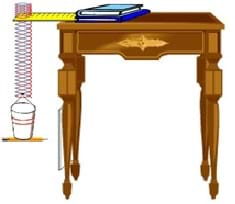Quick Look
Grade Level: Middle school
Time Required: 45 minutes
Expendable Cost: US $5.00
Group Size: 2
Subject Areas: Physical Science, Physics
Introduction
Bolded words are vocabulary and concepts to highlight with students during the activity.
What is weight? Weight is the force of gravity acting on a mass. Mass is a property of an object, whereas weight can change; for example, an object's weight on the moon would be different than on Earth. Historically, people have compared the weight of unknown things to a specific object of known standard weight. For example, people have used rocks or stones as standard weights to compare to heavy objects, and seeds or nuts as standard weights to compare to lighter objects. To keep weight "universal" from location to location and from item to item, a standard kilogram and a standard pound— which are special pieces of metal of a specific weight —are safely kept in Europe. Replicas of these weights are kept in different places all over the world, including at the National Institute of Standards and Technology in the U.S. (Boulder, CO). These other "copies" of the standard weights are used by engineers to make precise measurements all over the world, so that a pound in Brazil is the same weight as a pound in America!
Supplies
Each group needs:
- Slinky®
- 12" (30 cm) length of masking tape
- 2-3 textbooks or other similarly weighted items (provided by instructor/classroom)
- 1 ruler
- 10" (~25 cm) string
- 1 paper cup
- 1 marker
- 10 marbles
- 1 pencil (sharpened)
Groups share:
- 8-10 mystery weights (bag of pennies, standard weight[s], bag of washers, small rock, etc.)
Note: In advance, use a scale to weigh all mystery items, and write the name of each item and its weight on a notecard; however, do not provide students with this information! Also determine the weight of 1 marble.
Subscribe
Get the inside scoop on all things TeachEngineering such as new site features, curriculum updates, video releases, and more by signing up for our newsletter!Procedure
Procedures Overview
Students build spring scales and use them to compare the weights of various objects.
Procedure
- Divide the class into groups of two student each.
- Discuss with students the idea of weight vs. mass, as described in the Introduction.
- Explain that student groups will build and calibrate their own scales and use them to determine the weight of several objects.
- Explain how to build the scale (using the following instructions):
- Place a ruler on the edge of a desk/table so that it extends past the edge. Stack enough large books or other weighted items on the ruler to hold it down securely.
- Slip a Slinky on the end of the ruler so that the Slinky "stretches" down, but is at least 18" (45 cm) from the ground (see Figure 1). Tape the slinky to the ruler, being sure to only tape the top of the slinky (do not stop it from stretching down, to hang underneath the ruler). Note: if the Slinky stretches too near to the ground, have students "choke up" on the Slinky to take away some of its length.

Figure 1. The activity setup. - Using a pencil, poke two holes in the opposite sides of a paper cup, near the top edge.
- Tape a pencil (with the sharpened point towards the desk/table) to the bottom of the cup, making a "pointer."
- Run a piece of string through the cup holes and use it to attach the cup to the bottom of the Slinky. The cup should hang loosely from the Slinky.
- Tape a sheet of plain white paper to the side of the desk near the bottom of the cup, so that the pencil pointer shows the location of the cup on the paper when it is hanging from the Slinky.
- Using a marker, make a horizontal line on the paper where the pencil is currently hanging, and label it "0."
- Once the scale is built, have students use known weights (marbles) to make a scale on the paper.
- Have students add 1 marble to the cup, let it come to rest, then mark the location on the paper.
- Repeat repeat this for 10 marbles, adding them one at a time.
- Tell students the weight of one marble (which was weighed in advance by the instructor). Then, using the "mystery weights," have students weigh the objects using their Slinky scales and the information learned from the marbles. (Students should share the mystery weights, each group using one weight at a time.)
- Have students measure and record the estimated weight of each mystery object.
- At the end of the activity, have each group report their determination of the weight of each object .
- When all groups have discussed their findings, tell students the actual weight of each object.
Wrap Up - Thought Questions
- Was your scale accurate? Why or why not?
- Would your scale work on the moon? Why or why not? (Yes, it would.)
- Does the length of the spring affect the accuracy of your measurements? How?
More Curriculum Like This

Students learn about weight by building spring scales from slinkys and observing how they respond to objects with different masses.
Copyright
© 2013 by Regents of the University of ColoradoLast modified: May 12, 2022






User Comments & Tips